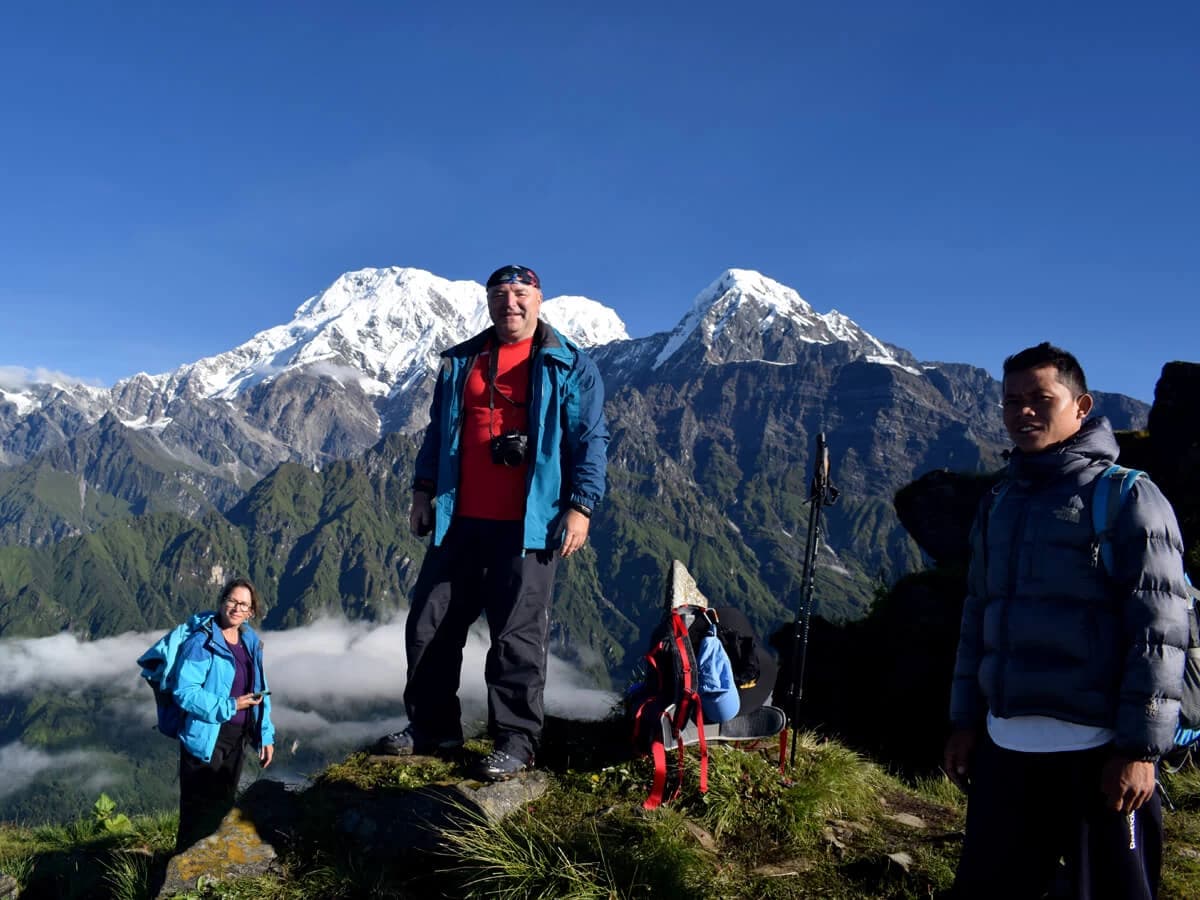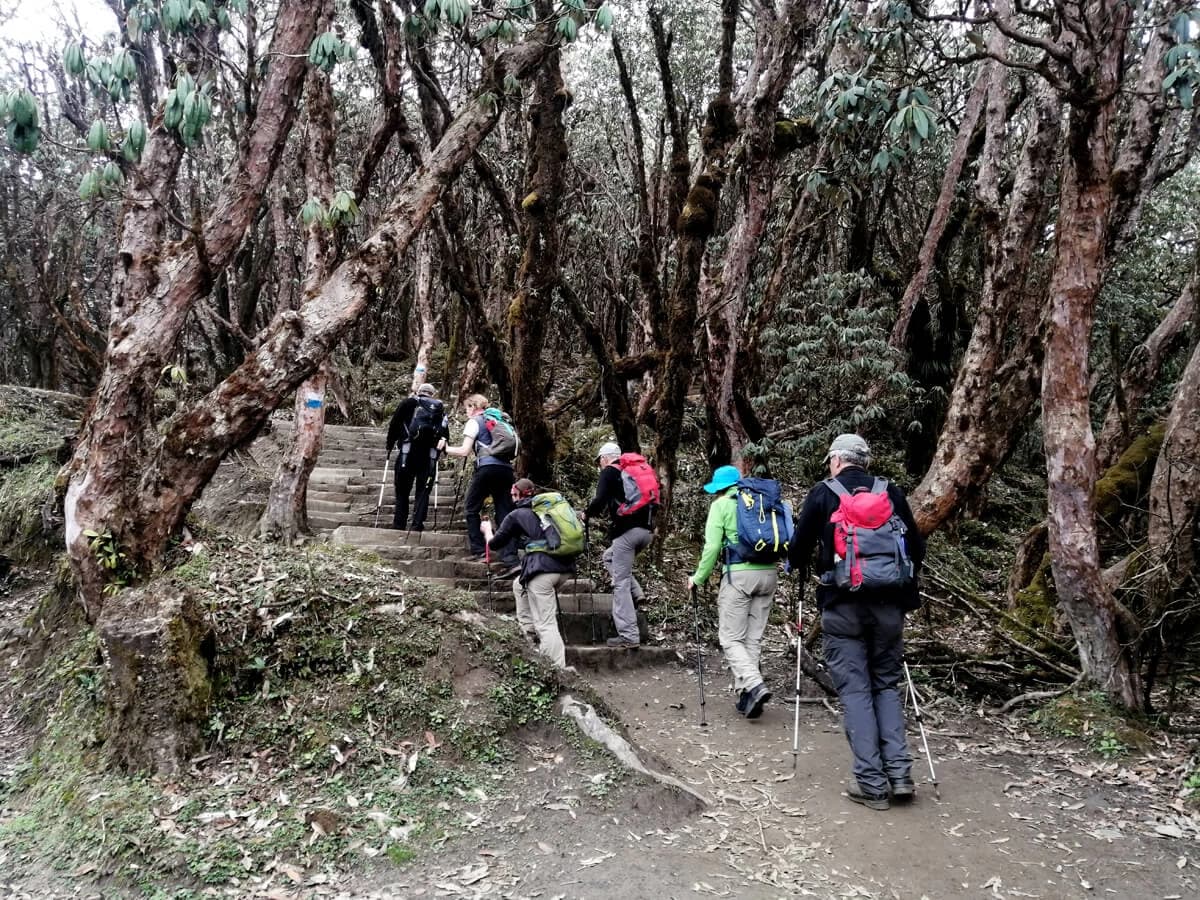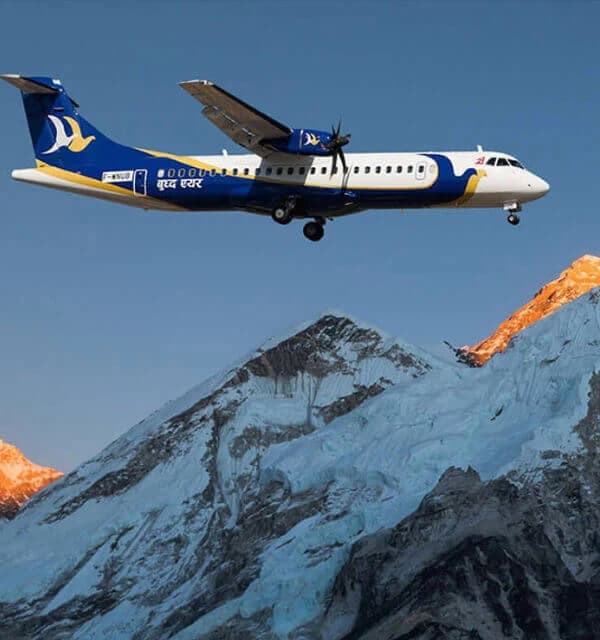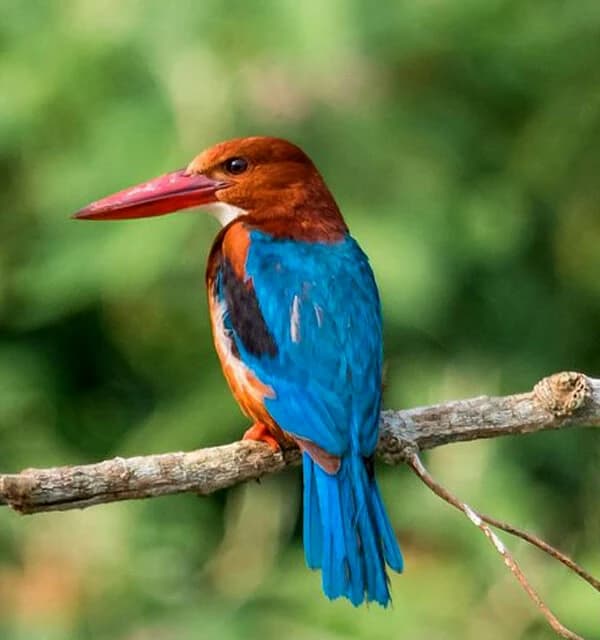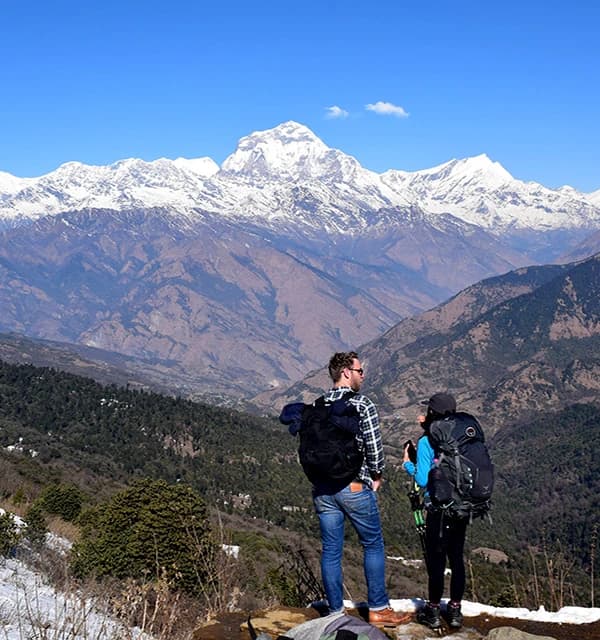The Mardi Himal trek is known for offering a spectacular close view of the Annapurna Range, along with the world-renowned mountain Fishtail and other popular mountains like Mardi and Hiunchuli. The trek takes you through a transition of vegetation and wildlife to the alpine landscapes of Mardi Base Camp.
Mardi Himal Trek - 7 Days
Overview
Mardi Himal Trek, best known for a short and scenic Himalayan adventure hiking in the Annapurna region north of Pokhara in central Nepal. The Trekking is also known best alternative to the 7-day Annapurna Base Trek, which serves a tremendous mountain view trek in a short period of time. From Pokhara, the gateway to the Annapurna hike, which offers several renowned routes, the Mardi Himal trek is prominent for its spectacular close-up view of Annapurna South, Fishtail, Hiunchuli, and Mardi Himal without the heavy crowd of Annapurna Base Camp and Poon Hill.
The journey begins from Kande or Phedi, taking you through lush Rhododendron forests, charming villages, seasonal alpine pasture of villages, and high ridges leading up to Mardi Himal Base Camp. The trek is not only limited to its natural beauty, but also the ethnic groups of Nepal, like Gurungs, which completes the whole trek - popular among beginner trekkers, who want a short but yet rewarding adventure trek at an affordable cost.
In this short description, we try to provide you with a detailed guide and insight about the Mardi Himal Trek regarding the best time to do this trek, difficulties and challenges, and its key attractions, etc.
Is this trek right for you?
Among its peers, the Mardi Himal Trek is considered a gem for both beginners and seasoned trekkers who want to experience a quieter side of the Annapurna. When it comes to panoramic views, Mardi is even more popular than poon hill and ABC. The trek starts from lush hills near Pokhara, with trails leading through the vibrant, colorful forest of rhododendron blossoms, and high ridges that gradually reveal a stunning, close view of the Himalayas. Unlike the crowded treks in the Annapurna Region, Mardi offers solitude and discovery with panoramas of Machhapuchre, Annapurna Range, and Hiunchuli so close you feel like you can reach out and touch them at every turn. This trek unfolds for every trekker seeking a hidden gem with a blend of accessibility, natural beauty, and unforgettable memories.
This trek is a go-to place for those who seek an unparalleled view of the Himalayan Range with a unique blend of natural beauty and cultural richness. The trails are mostly uphill but still suitable for all age groups and trekkers. If you have a heart and spirit to travel the high Himalayas of Nepal as closely as possible, then this trek is made for you.
Best time (month and season) to do Mardi Trek
Mardi Trek is known for its visually stunning panoramic scenery of the Himalayan Range with a colorful forest of rhododendron blossoms. Experiencing the full potential of the journey can be quite challenging, as Nepal has two peak trekking seasons each year. Seasonal months start from March to May and September to November, as Nepal experiences stable weather, which is suitable for adventure trekking and traveling. Trekkers prefer these months due to it’s slight difference in experience.
Spring Season (March – May) / Pre-Monsoon
- Warm days make trekking pleasant.
- Less haze makes mountains visible.
- Colorful forest of Rhododendron Blossoms.
- Dry and safe trails.
Autumn Season (September – November) / Post-Monsoon
- Stable weather, perfect for trekking.
- Clear and crisp sky makes the mountains fully visible.
- Ideal time for trekking and other adventure activities.
- Golden and reddish forest.
- Coincides with major festivals: Dashain and Tihar.
Both seasons are suitable for trekking and traveling in Nepal, as Nepal experiences stable weather and offers memorable experiences. Choosing the season depends on what you want to get out of the trek, from panoramic views of mountains with vibrant, colorful forests and cultural depths.
Mardi Himal Trek – Difficulty
Nepal offers various trekking routes, from high Himalayan passes to lush hills and colorful forests of seasonal flower blossoms. Nepal is a heaven for those who seek adventure and hardship with a rewarding journey. From green hills to high alpine lands and passes, trekking difficulty varies depending on the route and region.
When considering all the factors, Mardi Trek is perfect for both starters and veteran trekkers despite the possible difficulty of the trip. The trail passes from nearby villages and takes you through the reddish forest of rhododendron blossoms and high alpine passes in just a few days, but the trek can be extended with acclimatization days. Despite such a geographical structure, the routes follow a standard pattern to make it easier for trekkers to walk uphill. The whole trip covers a maximum altitude of 4500M above sea level, which is higher than ABC. Due to the flexibility of the trek, it can be modified in accordance with the traveler's needs, making it an age-fit trek.
(If you want a shorter and challenging trip, then you can check out our Mardi Himal trek – 4-day itinerary as well.)
Facilities in the Mardi Himal Trek
Accommodation and food in the trekking region depend on the popularity and the remoteness. For instance, Everest is a remote trekking region yet offers the best and most globally known luxury facilities, from cafes to restaurants and well-developed lodges. The same can’t be said for Mardi Trek, despite its popularity; camps in the Annapurna Region after a certain altitude follow a similar design in housing, i.e., teahouses and lodges. The rooms have basic equipment with a bed and a drawer in most places, attached bathroom rooms are limited, and some lodges have a common shared toilet. At high camp, lodges are fewer and book up fast, trekkers often sit around the dining hall heater sharing stories. Despite these limitations in rooms, a hot shower or bucket baths are arranged at extra cost in high altitude, if needed. But when it comes to food and drinks, every lodge provides a variety of drinks for lunch and dinner, including breakfast. The quality of the food may not match 5-star restaurants, but it is still satisfactory. Let’s highlight some points on what you may experience in camps: -
- Lodges accommodate shared rooms, 2 people per room.
- Basic equipment in the room.
- Limited attached bathroom, possible shared toilets.
- Food varieties for drinks, lunch, dinner, and breakfast/
- Limited Wi-Fi connection requires an extra cost.
- Mobile charging requires an extra payment in lodges.
The facilities in Mardi Trek are quite limited, but the beauty of Mardi brings untroubled tranquility, peace, and a calm state to one's mind as you take a tea break across a giant snow-capped mountain surrounded by a forest full of seasonal flowers.
Mardi Trek Highlights
The Mardi trek is known for its exceptional view of the Annapurna Range and Fishtail, including Mardi Himal. Unlike the cramped feeling of Annapurna Base Camp and Poon Hill, the Mardi Himal trek offers a secluded path through green hills and alpine grasslands. In spring, the forest is full of different rhododendron species from the very beginning of the trek, making it a pleasant and calm experience. The shift in vegetation after the low camp from green hills to alpine and dry grasslands to rocky trails showcases the perfect blend of vegetation. The Mardi trek is known for its short yet scenic views of the Himalayan Range, with a touch of Gurung culture giving it a meaningful experience.
The Gurung people are one of the main ethnic groups living in the Annapurna Region, also called Tamu. Gurung villages in lower Annapurna, like Ghandruk, Landruk, Dhampus, and Kalimati, along the trekking trails, give travelers a chance to experience their traditional and unique lifestyle with warm hospitality. Indigenous groups like the Gurung reside in hilly areas, following a traditional lifestyle, which can be seen in Ghandruk village. From the stone architecture to the humble farm life of Gurungs, the Mardi trek is not only about its undeniable natural beauty, but also the serenity of the local people as well, which truly completes this trek.
Let’s highlight some of the points on what the trek is known for: -
- Stunning close view of the Annapurna South, Fishtail, and Mardi Himal.
- Colorful forest full of different Rhododendron species.
- Cultural and architectural richness of Gurungs.
- Possible festivals like: Tamu Lhosar, Maghe Sankranti, and Buddha Jayanti.
- Traditional Gurung dances like Ghatu and Sarathi.
The Mardi trek showcases one of the beautiful natural and cultural riches. As you walk through the human legacy in villages to the abundant forest of rhododendron and transcend to the high Himalayas, reaching out to the sacredness of the mountains, the journey leaves you with pleasant memories of the people and nature.
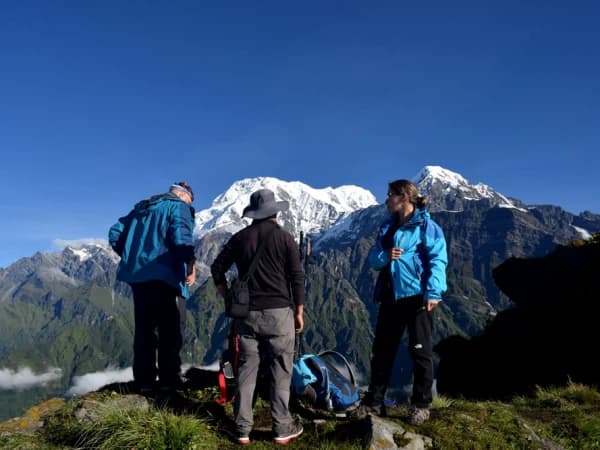


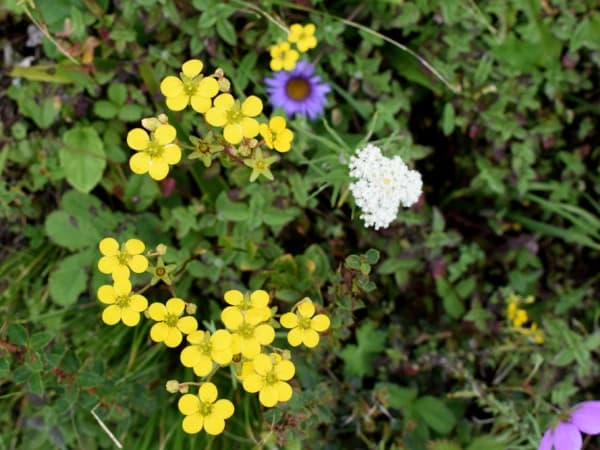
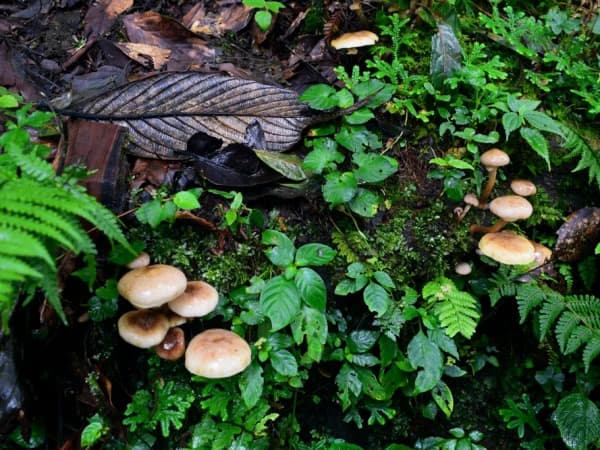
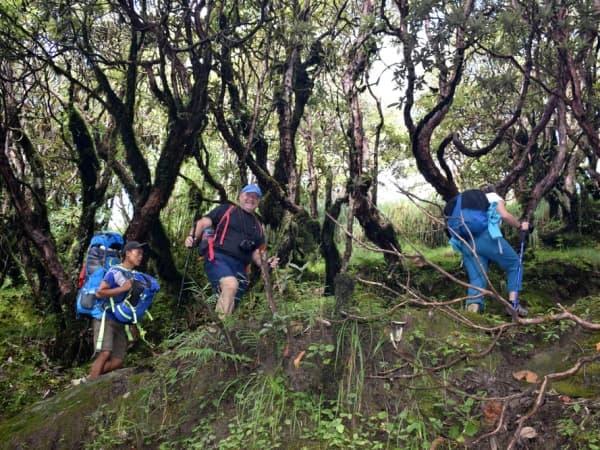
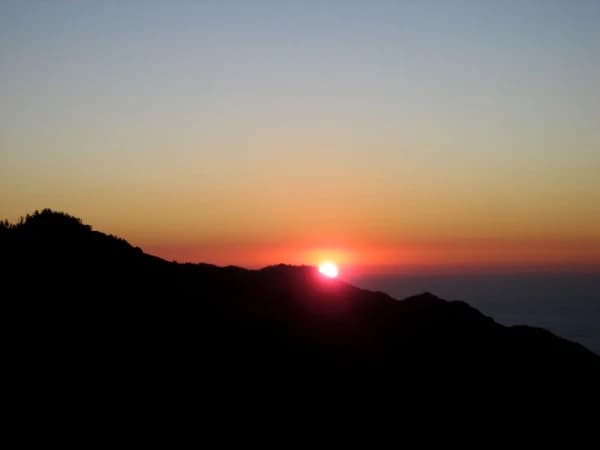
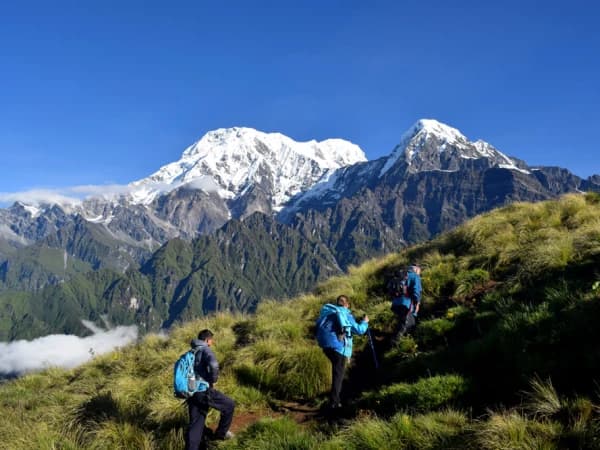
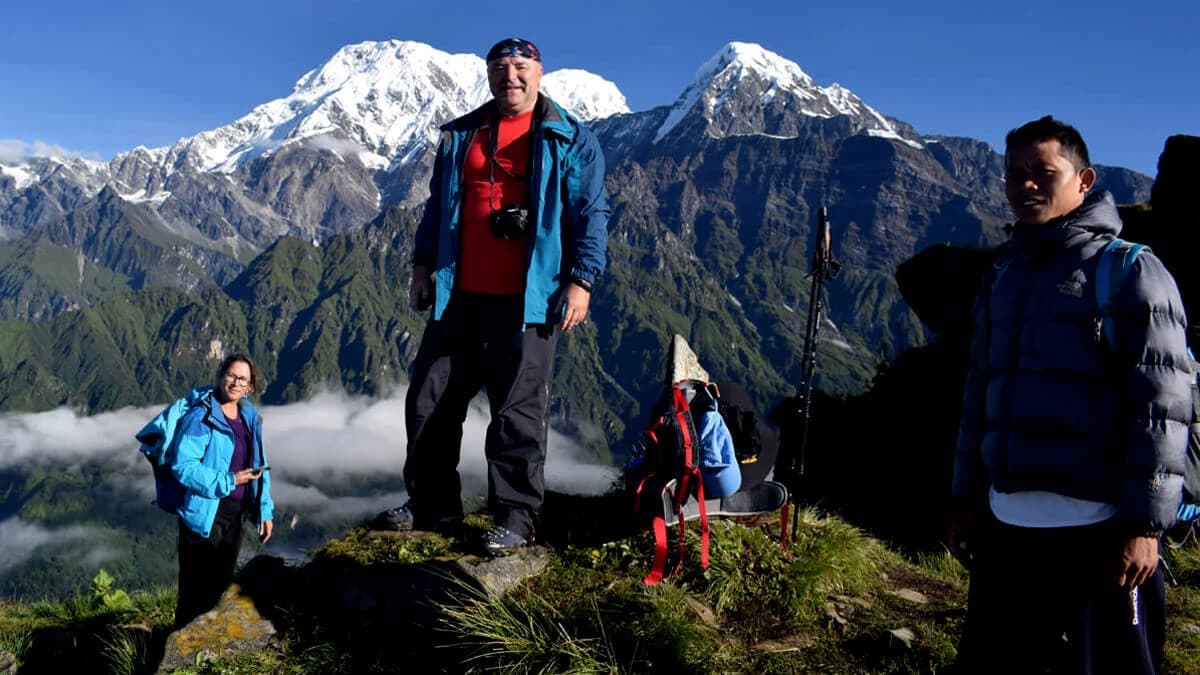
Our journey begins with a direct domestic flight from Tribhuwan International Airport, Kathmandu, to Pokhara. The flight time is approximately 20-30 minutes without any delays. After a successful check-in at Pokhara Airport, private transportation will be arranged to Kande, our starting point for the trek. It takes approximately 2-3 hours from Pokhara Airport to the trek starting point. The vehicle will drop you at Kande, and once you are ready to set off, the trek starts gradually through the rhododendron forest and small villages to Australian Base Camp. After a morning Lunch and proper rest with a panoramic view of the Annapurna Range, you walk through the dense forest of the hilly region and reach Pitam Deurali, where you rest for the day at a trekking lodge.
After an overnight in Deurali, we continue our trek through dense forest, as the view of the mountain range is hidden behind the giant hills of Nepal, and we walk through the wilderness along the hills. With an everlasting forest of rhododendron, oak, maple, and laurel, the trek continues through a natural tunnel of greenery before reaching a small settlement of lodges known as Forest Camp.
Leaving Forest Camp behind, we continue our ascent towards Low Camp. As we continue the trek, the vegetation shifts noticeably, with rhododendrons dominating the whole region. The seasonal blooms make the whole region full of vibrant colors and a feast for the eyes, surrounding the camp area where we have a quick breakfast. Once we leave Low Camp, the surrounding area becomes more open as we ascend towards Badal Danda, marking the start of Alpine Highlands. After a short hike from Low Camp, multiple grasslands can be seen, which were used for herding, and a view of the Himalayan Range welcomes us in the Himalayas. Overnight in Badal Danda.
Continuing the ascent, our hiking days become shorter as we continue towards high altitudes for proper acclimatization. From the 4th day of the trek, our trails become more challenging and memorable. We continue the ascent on the rocky hills with the Annapurna South on the left, Machhapuchre, and Mardi in the front. After a moderate hike for the day, we stay at one of the lodges in High Camp.
The fifth day of the trek can be strenuous; leaving all the gears behind and carrying the necessary items, we hike in the early morning to the renowned Mardi Base Camp or Mardi View point, depending on the itinerary. Once we reach our destination and begin our way down towards High Camp to collect our baggage, leaving behind what we came for, we begin retracing our trails towards Low Camp. We rest for the day in a lodge surrounded by rhododendron blossoms during the season.
We retrace our trail back to Forest Camp from Low Camp after a possible breakfast and take a separate route from Forest Camp towards Kalimati, a small village on the outskirts of Pokhara. The trails are now again through dense green forest and constant downhills till we reach a small village of 6-7 houses and farmlands, from where we ride a Local Jeep to Lumle and to Pokhara ultimately along rivers, waterfalls, and countless local markets. At Pokhara, we drop you off at the Hotel you are staying at. Dinner for tonight is not included, which leaves you plenty of time, options, and personal space for yourself.
With a long ride to Kathmandu from Pokhara, our little journey comes to an end with empty pockets and heavy memories. After a quick breakfast at the hotel, you take a bus to Kathmandu from the tourist bus park, which approximately takes 8/9hrs or even 10 hours depending on the traffic. Once you arrive at Kathmandu, you are transported back to your hotel with warm farewells.
P.S. Dinners in Pokhara can be arranged with your trek guide, if you desire to have a final moment with your trek partners who accompanied you throughout your journey.
Wilderness Excursion (WE) aims to keep to the day-by-day itinerary of the Mardi Himal trek detail as follows, even though there might be some flexibility because of local situations or other issues beyond our control. If this is the case, the trek leader will do everything possible to work out the changes to the itinerary in order to minimize your inconvenience.
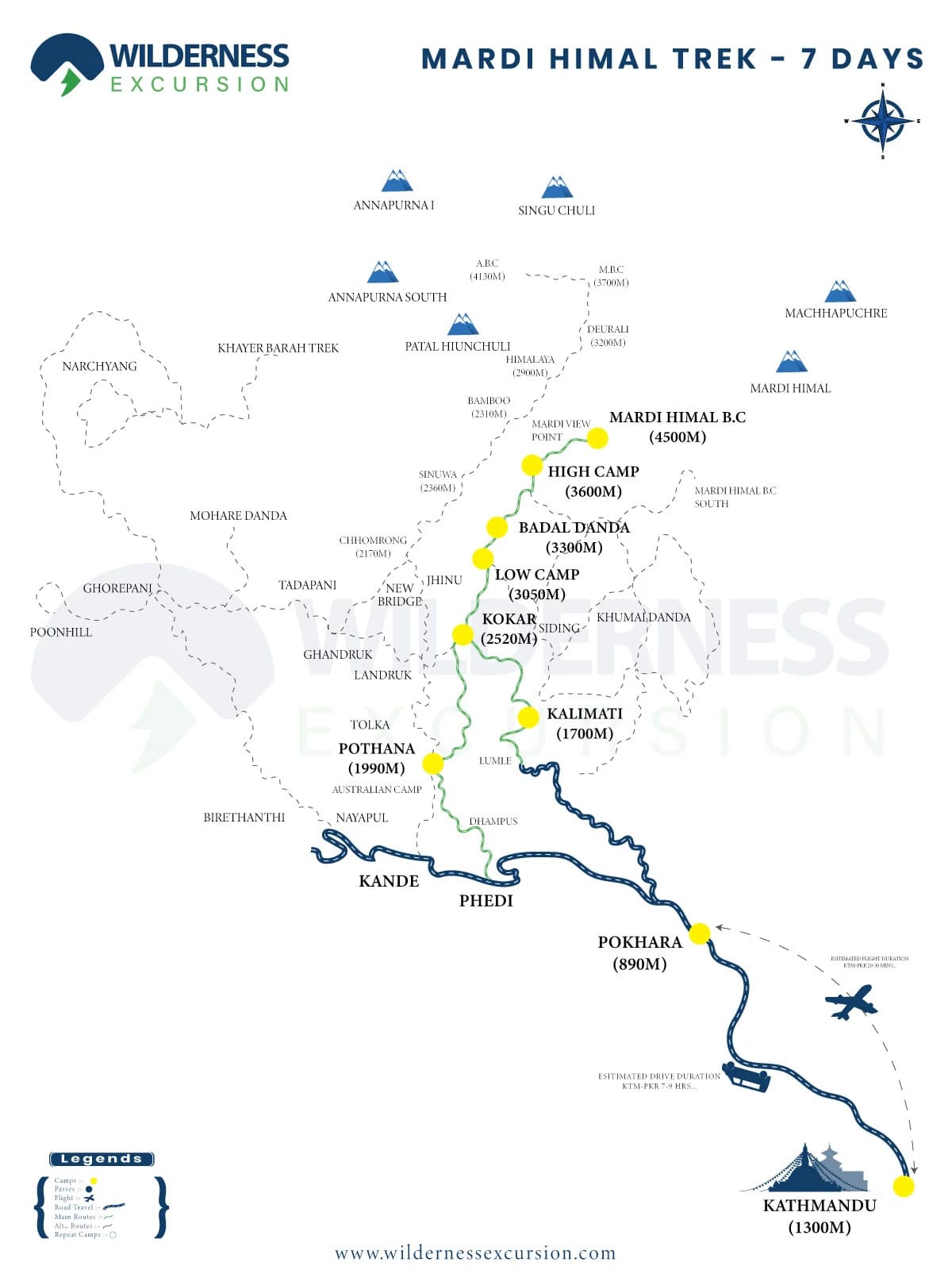
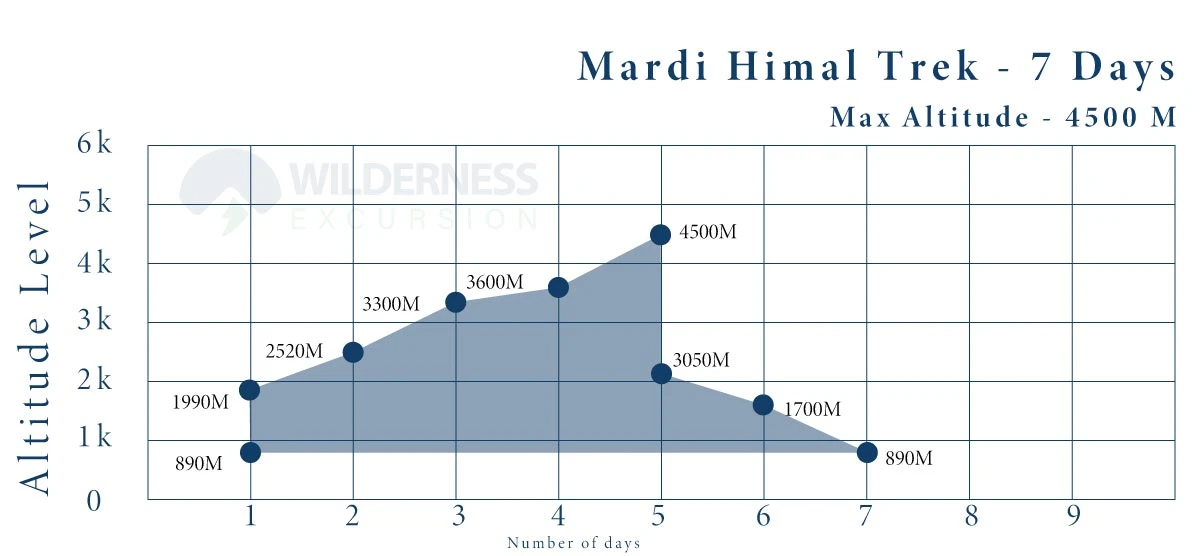
- 1 night sharing a twin/double deluxe room in a 2-star hotel in Pokhara.
- A registered local Mardi Himal Trek guide for 7 days.
- Meals: 6 breakfasts, 6 lunches, and 5 dinners during the trek.
- Sharing twin/double bed rooms in teahouse lodges during trek.
- Accommodation, food, salary, equipment for your guide and porters.
- Pokhara - Kathmandu by A/C tourist coach.
- Transfers by car/cab or jeep, depending on group size, to/from trekking.
- Necessary insurance for your guide and porters.
- Mardi Himal trekking permits.
- Local taxes and documentation charge of Mardi Himal.
- Transfers, accommodation, and meals in Kathmandu.
- Meals in Pokhara, except breakfast in the hotel.
- Guided sightseeing and monument entrance fees in Kathmandu and Pokhara.
- All bar bills, beverages such as Coke, Fanta, and mineral water
- Personal insurance, laundry service, and trekking gear.
- Rescue operation charge in case of emergency.
- Tipping your guide and porter.
Set out on your adventure trip to the famous Mardi Himal Trek in Annapurna with Wilderness Excursion, a trekking agency with decades of excellence. We offer a selection of extra services (add-ons) with extra cost that will assist you with a hassle-free booking for an incredible trekking experience.
- Pokhara - Kathmandu Flight USD 100: A scenic return flight to Kathmandu from Pokhara after the Mardi Himal Trek with an extra cost of USD 100 per person.
- Double Room Accommodation Booking in Kathmandu USD 45: Extra night accommodation booking in Kathmandu on a twin or double bed room basis costs USD 45 per night with buffet breakfast. The accommodation will be in Hotel Kilash Kutee or similar.
- Single Room Hotel Booking in Kathmandu USD 35: A single deluxe room booking in Kathmandu with buffet breakfast USD 35 per night in Hotel Kailash Kutee or a similar category in Kathmandu.
- Porters USD 20 per day: Porters can be arranged with an additional cost to make your journey easier and more comfortable. One porter for two trekkers.
Check our published date! If it doesn’t match, we are happy to customize your tour perfectly to suit your interests and needs, creating a unique travel experience for you
Permits and Entry
Mardi Himal trek falls under the Annapurna Conservation Area. Trekkers who want to trek in the Annapurna Region are required to get ACAP permits from the Nepal Tourism Board. For more information about permits, follow the given link.
Packing and Preparation Tips
Trekking in Nepal is tricky since packing can differ depending on which route you are trekking. All the trails lead you to the remoteness of the country, to high alpine altitudes, facilities may differ, but there are some packing methods on what to pack and how to pack.
- Layer your clothes and utensils for trekking back.
- Layer your outfits for the day trek.
- Carry a minimum 2L of water bottle. Filterer and purifier tabs if needed.
- Pack energy bars, light snacks, and chocolate bars. If needed.
- Avoid cotton clothes when trekking.
- Personal first aid kits with basic medicine and rehydration powder.
- Power banks or portable solar backups.
- Headlights and hand torches.
- Personal sleeping bag. If needed.
- Sunglasses, a buff, and a pair of gloves.
- Waterproof essentials like raincoats and rain covers for the bag.
For more information regarding the packing tips, follow the link.
Travel safety information
Nepal is safe for both local and international travelers, since the country is tourist-focused and most of the remote places are well prepared for travelers. Despite these, some unexpected incidents may cause trouble during travel, so a few precautions can be applied.
- Keep your important documents safe and separate from the main luggage.
- Carry a pepper spray in case of emergency.
- Save emergency contact information.
- Never separate from the group while trekking.
- If possible, hire a guide from a registered company.
(If you want more tips for a successful trek, please follow the link given.) https://wildernessexcursion.com/blog/tips-for-a-successful-nepal-trek
Myths and stories of the Annapurna Region
According to legends, Machhapuchre (fishtail) is believed to be the home of Lord Shiva. The sharp ridges and icy summit are believed to be his throne. Because of these sacred beliefs, the mountain is off-limits to climbers, making it one of the few major Himalayan peaks never officially summited. In fact, in 1957, a British expedition reached just below the summit but returned out of respect. Since then, it has remained untouched and pure. Locals also believe Machhapuchre stands as a protector of the Annapurna Valley, watching over travelers and villages alike. The name Machhapuchre or Fishtail originated from its unique fishtail shape; some say it resembles the trident of Shiva.
Machhapuchre is one of Nepal’s most sacred peaks and is directly tied to the Mardi Himal region since Mardi lies on its eastern ridge. Mardi is often seen as a spiritual companion of the fishtail and a resting place of the gods where shamans and monks once meditated. The lower altitudes of the Mardi trek are said to be inhabited by spirits and deities who test the purity of the traveler's heart. Those who travel with malice and greed are faced with misfortunes on the trail.
Mardi Himal is located to the north of Pokhara city. It is a famous one week trekking destination in Annapurna region in Gandaki Province. Mardi Himal Base Camp that is situated at the elevation of 4500 meters below Mardi Himal (5,587m). From Annapurna Base Camp, it is to the east and literally it is below fabulous Mount Machhapuchhre (6993m) that is also known as Mount Fishtail.
Like the other areas in Nepal, Mardi Himal Trek faces four seasons namely, autumn, spring, summer and winter. All these seasons fall under different months and have various weather and climatic variations. Usually Mardi Himal trek is doable between September - June. Mid September to May are dry months in Nepal. Let us discuss the best time of the year for Mardi Himal Trek.
Mid September – November: This is the peak trekking season in Nepal. September to November belong to fall season. It has mid temperature, low lands are green and blue sky in the.
December – February: It is winter and Mardi Himal is doable in this time. There is chance of heavy snow fall if the weather is bad; it is cold in higher places but it in not unbearable. Sufficient warm clothing is high suggested if you are trekking in winter.
March - May: Which is spring season, the second best time to trek in Nepal and Mardi too. It is time of rhododendron bloom. There is rare chances of rain and thunder storm sometimes and also chances of snowfall in March as well.
June – August: It is summer or monsoon time in Nepal. Mardi Himal trek can be very wet and views can be cloudy most of the times. Rare chances of blue sky and stunning view sometimes. Leeches are so active on the Mardi Himal route, mostly on the trail between Dhampus – Low Camp. However it is best time to trek for botanical researchers and alpine flower lovers. It is quiet and peace as there are less trekkers.
Guide hire cost USD 25 a day + 13% vat
Trekking Permits USD 40 per head
Tranfers USD 25 per head based on 2 people group size
Meals: USD 3-5 per meals, tea / coffee USD 0.7 to USD 1
Accommodation USD 5-6 per night / room
Our inclusive package cost is 523 per person based on double occupancy basis including 2 nights deluxe room with breakfasts in best deluxe budget hotel in Pokhara, all meals and accommodation in trek, guide, porters, trekking permits and transfer between Kathmandu and Pokhara.
Yes, you will have to carry some cash for your personal expenses that are not service-included within the package cost, such as hard drinks, beverages, internet, etc. And there are no banks and ATMs on the route.
To avoid AMS (Altitude Mountain Sickness), you should follow the trekking guidelines and protocols that help prevent it. Typically, it is advised gentle hike, gradual altitude gain, and avoid drinking and smoking, and trek with an experienced and certified guide to ensure your trek is safe.
Mardi Himal View Point, which lies at an altitude of 4200 meters (13800 ft.) that provides a mesmerizing view. Usually, hike in the morning to Mardi Himal View point and Mardi Himal Base Camp (4,500 m) in the morning and retrace back according to your plan and itinerary. It is approximately 1.5 hours to reach View Point from Mardi Himal High Camp
In term of difficulty it doesn’t require any technical and ice picks needed but it goes up to 4500 meter in short time (3-4 days) and the highest elevation you sleep is at 3700 meter. The trail is mountain and it not well paved, goes through dense forest, tree roots, rocky sections and mountain terrain. The exact level of difficulty depends on every individual’s walking habit and stamina. Though we label this trek as Moderate or easy for regular trekkers and it can be hard for beginners or inexperienced trekkers. It is a moderate trek for young and fit trekkers. But you will gain altitude as you walk.
I think Nepal is the only country where distance is measured in hours and days. Normally we walk 9-14 Kilometer a day so this should be some 70km (43 miles). Also the distance varied by trek starting and ending points as this trek can be done in 5 days minimum and max. 7 days for relaxing trek to ensure safe and pleasant trekking holiday considering AMS (Altitude Mountain Sickness)
Sure. You are welcome to leave unused stuff at your hotel in Pokhara, as most hotels in Nepal provide free storage for guests. If you have any valuable items you wish to store, please notify your hotel and also speak directly with our booking manager at Wilderness Excursion to arrange secure storage.
An Unforgettable Ghorepani Poon Hill Trek with Yuhan – Highly Recommended!
My Ghorepani Poon Hill Trek with Yuhan as my guide was an incredible experience. From start to finish, he was professional, attentive, and genuinely caring, ensuring every moment was enjoyable....

Our first brilliant time in Nepal – Highly Recommended!
My partner and I chose Nepal for our travels and discovered Wilderness Excursion through TripAdvisor, where we found outstanding reviews. After reaching out via email, Pradip responded promptly, answering...

Mardi Himal Trek 7 Days - A natural highlight in Nepal
Mardi Himal Trek, April 22. I recommend this trek to anyone who wants to enjoy Nepal's diverse nature. We started in Kande. The path led us through beautiful rhododendron forests...

